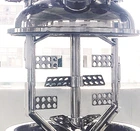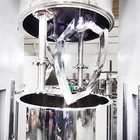Integrating development, manufacturing and sales, as a first-level mixer emulsifier factory.
What is the Difference Between a Homogenizer and a Vacuum Emulsifying Mixer?
When it comes to processing emulsions, creams, gels, or suspensions, many machines seem to do the same thing at first glance — they mix, blend, and homogenize. However, just because they look similar doesn’t mean they’re built for the same job.
In this article, we break down the real differences between a homogenizer and a Vacuum Emulsifying Mixer, so you can make an informed decision for your production needs.
Purpose & Applications
Before comparing how they work, it’s important to understand what each is designed to do.
|
Machine |
Main Use |
|
Homogenizer |
Reduces particle size and creates uniform textures — ideal for low to medium viscosity liquids like milk, juice, and simple emulsions. |
|
Vacuum Emulsifying Mixer |
Creates stable emulsions and blends under vacuum — essential for viscous, high-quality formulations like creams, ointments, and cosmetics. |
Both mixes, but one focuses on efficiency for liquids, the other on precision for complex materials.
How They Work
|
Machine |
Working Principle |
|
Homogenizer |
Applies high pressure or mechanical force to push liquids through narrow gaps, breaking down particles to reduce size and increase uniformity. |
|
Vacuum Emulsifying Mixer |
Uses planetary mixing blades and a high-speed emulsifying head inside a vacuum-sealed tank to combine and degas viscous ingredients. |
So, the Homogenizers are effective for simple textures where Vacuum mixers are better for air-sensitive or thick materials that require delicate balance and consistency.
Product Type Compatibility
|
Machine |
Viscosity Range |
|
Homogenizer |
Best for low to medium viscosity (liquids, thin suspensions) |
|
Vacuum Emulsifying Mixer |
Built for medium to high viscosity (creams, pastes, gels, etc.) |
If your product is sticky, thick, or must be bubble-free, the vacuum mixer is the right fit.
Vacuum Functionality
Removing trapped air during mixing is key to improving product shelf life, texture, and stability — especially in sensitive industries like cosmetics and pharmaceuticals.
|
Machine |
Vacuum Capability |
|
Homogenizer |
Typically no vacuum; open mixing process |
|
Vacuum Emulsifying Mixer |
Built-in vacuum system removes air, prevents oxidation, and ensures consistent product quality |
If your products require high precision and stability, the vacuum emulsifying mixer is the ideal choice to meet these demanding standards.
Level of Precision & Product Quality
|
Feature |
Homogenizer |
Vacuum Emulsifying Mixer |
|
Fine particle size |
Yes |
Yes |
|
Bubble-free product |
Not guaranteed |
Built-in vacuum degassing |
|
Batch consistency |
Moderate |
High |
|
Sensitive formulas |
Not ideal |
Perfect fit |
So, Which One Should You Choose?
- If your product is simple, fluid, or low viscosity, and you’re processing large volumes quickly, a homogenizer may be the cost-effective solution.
- If you’re producing high-value emulsions, like creams, gels, ointments, or cosmetics, where stability, vacuum, and consistency are critical — the Vacuum Emulsifying Mixer is worth the investment.
Additional Considerations
- Training & Operation: Homogenizers are simpler and easier to operate. Vacuum mixers require more training but offer automated, programmable systems that can streamline production once setup is complete.
- Cost & Investment: Homogenizers are generally more affordable. Vacuum mixers are more expensive, but offer better long-term results and reduced waste or reprocessing for high-end products.
- Customization: Most Vacuum Emulsifying Mixers offer customizable options — control systems, tank size, heating/cooling, discharge methods — tailored to your product.
Final Thoughts
In the end, your decision should be based on your product’s texture, sensitivity, and quality requirements — not just the machine’s name or shape. When quality, stability, and process control matter, the Vacuum Emulsifying Mixer stands out as the tool of choice.
Still not sure which one suits your production needs?Contact our team — we can help analyze your product and guide you toward the right solution, even offering customization based on your workflow.














































































































